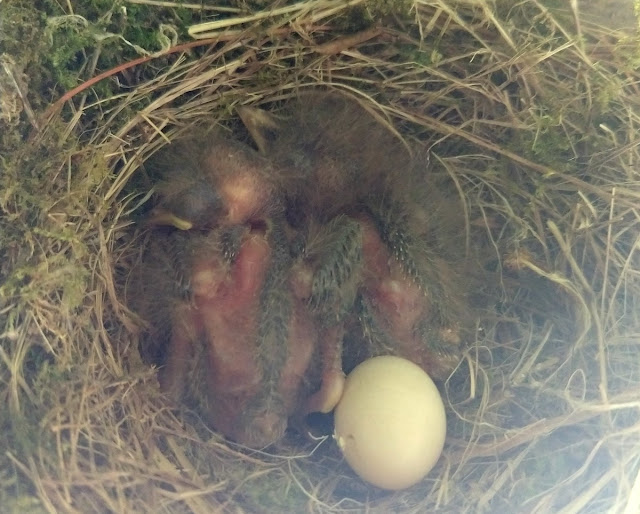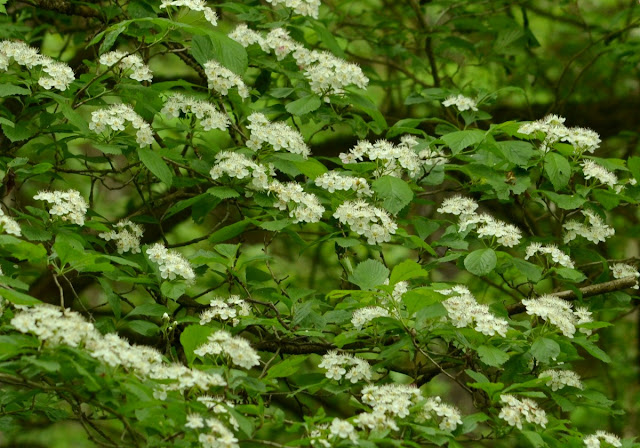Here are the rest of my sightings from our house since mid-March, continued from the previous post!
More Birds
We've had a lot of nesting drama this spring. First, pair of Eastern Bluebirds developed a strong interest in one of our nest boxes. Here's a female bluebird visiting the box on March 15; I think she looks very pretty backlit by the morning sun:
The pair eventually went for it, and the female built a large (towering, really) nest with grass and lots of pine needles. Here's the finished nest on April 29:
The male was around, too, chasing off other birds and generally keeping an eye on things. Here he is on April 30:
On May 4, I found a single blue egg in the nest:
And then that was the end of the bluebirds' nesting attempt here! A week later, the nest still only had the one egg, and the adults seemed to have disappeared. Sometime after that, the egg was gone and the nest untidy. I'm not sure what happened or why the bluebirds left, but at least this all happened early in the season, and hopefully one or both of them will still have time to make another go at nesting this year.
The Eastern Phoebes seemed to consider putting a nest over our front door again this year (as they have for at least the past two years), but in a surprise twist, the female phoebe built her nest on some electrical conduit under our back deck instead. The first egg appeared in the nest on May 2, and all seemed well and normal until I peeked into the nest on May 9 and saw an unusually large and speckled egg tucked in among the pearly white phoebe eggs -- a Brown-headed Cowbird had found the nest:
Brown-headed Cowbirds are native birds that don't build any nests of their own, but rather lay their eggs in the nests of other bird species, usually to the detriment of their hosts' actual brood. My first reaction on seeing this egg was disappointment, because I love phoebes, and it's been such a joy to see them raise their babies in previous years. But there's really nothing to be done; besides the fact that it's illegal to mess with native birds' eggs (without proper permits), there are all sorts of other reasons why it's a bad idea to remove a cowbird egg (see this site for a bunch of interesting points). So with all that in mind, I decided to view this nest as a chance to watch weird nature at work. I'd never gotten to actually see a cowbird being raised by host parents, after all. And, in the end, everything has worked out rather well (so far), which I suspect is mainly because these two adult phoebes are master hunters and excellent providers for their young dependents. I see the two of them snatching up bugs in our yard and meadow almost constantly. Here's one of the parents in a bush near the nest on May 16:
The cowbird was the first to hatch, on May 20:
I worried for a while that the phoebe eggs wouldn't hatch at all, but on May 25 (with the cowbird baby already six days old), the first phoebe baby appeared (wow, look at that size difference):
By May 29, only two of the phoebe eggs had hatched, and those two nestlings were pretty well dwarfed by the hulking cowbird baby:
And when I checked the nest on May 31 (only 11 days after hatching!), the cowbird had departed, and the two phoebes had the nest to themselves:
When I checked again yesterday, the two phoebe babies were still growing and doing fine. It's true that two phoebes is significantly fewer than the five original eggs, and some of that loss may have been because of the cowbird, but two phoebes is still better than no phoebes (which was another possible outcome), so I call this a win. Overall, I'm super impressed with these phoebe parents, who raised a cowbird nestling to fledging while also incubating and feeding their own babies. They deserve an award.
After a long period of indecision, a pair of Tree Swallows also took up residence in our second nest box, and that nest is going strong, with the first egg appearing in the nest on May 24. I love having these beautiful birds here, making their bubbling sounds and swooping around our meadow. I also appreciate how relatively amiable this particular pair of Tree Swallows is; these birds sit politely at their box while I work in my garden not too far away, whereas I've met Tree Swallows in other places who dive-bombed me for walking by at a further distance. Here's our pair at their box, the female peeking out of the entrance hole, and the male in his typical perch on top of the box:
Other birds are starting to nest in our yard, too, but these attempts are in their earliest stages, so I'll hold off on reporting about them until I know more.
Finally, this spring has brought an exciting bird milestone: We reached 100 species on the list of birds we've seen/heard on our property! Bird #98 was a Double-crested Cormorant who flew overhead (a pretty strange bird for a yard more than 10 miles from the nearest lake). Bird #99 was a group of Common Nighthawks who hunted over our meadow and woods for several evenings at the end of May, making their weird honking calls the whole time (what an awesome sight):
Bird #100 was a Mourning Warbler -- also a totally new bird for me -- who popped into our yard briefly near the end of May. 100 species of birds... wow. And we won't stop there! This place continues to amaze me.
Amphibians
We got to see several amphibians this spring. On the night of April 8, we went in search of the very loud Spring Peepers we were hearing, and after some careful searching we successfully spotted a few of these tiny frogs calling at the small pond (more of a large puddle really) in our woods. And then when we returned to the house, of course, who should be waiting at our front door, out in the open and easy to see, but a Spring Peeper. Oh well! I love these little frogs, regardless of whether we go looking for them or they come to us:
The night of April 12 was warm and rainy, and we spent some time shepherding peepers and Spotted Salamanders across our road. Unfortunately, several of these creatures had died trying to cross, but we made sure that at least a few got to the other side safely. Spotted Salamanders are wonderful, and I love getting to see them out and about on these early spring amphibian nights:
On May 16, I was surprised to find a Red-backed Salamander in our basement; it had crawled inside the warm, humid stand where I was starting seedlings for the garden. I find these salamanders fairly frequently in our woods, but transporting this individual outside was a great opportunity to admire it up close. Sooo cute:
Plants
Here are a few wildflower sightings to round out this spring summary. On April 7, eager for any signs of growing things, I admired the tiny new leaves of Wild Lupine (Lupinus perennis) in our meadow; this is second-year growth from seeds we scattered in 2017:
By May 26, these plants had become glorious mounds of greenery, with spires of purple/blue flowers:
I expected the lupine blossoms to be beautiful from afar (and they are), but I didn't know that these flowers would also have intricate and subtle markings up close:
The diversity of spring wildflowers in our woods is somewhat limited, but they're out there. I was happy to catch this Early Blue Cohosh (Caulophyllum giganteum) in bloom on May 4:
Likewise with this Starflower (Trientalis borealis) on May 24:
An Allegheny Serviceberry (Amelanchier laevis) I planted last year produced beautiful ribbon-y blossoms this sping; here's a picture of these flowers from May 4:
And on May 29, the many hawthorn trees in our woods were covered with blossoms (many more than I saw on these trees last year):
And finally, although it's not a native plant, I can't stop admiring the blossoms on Germander Speedwell (Veronica chamaedrys), which is common in all the spots in our yard where I haven't mowed:
And that's most of spring! There's still a lot of growing (for plants and animals) ahead in the upcoming months, but the wild rush is mainly over. I'm excited to see what happens next!
























What a wonderful bunch of sightings.
ReplyDelete